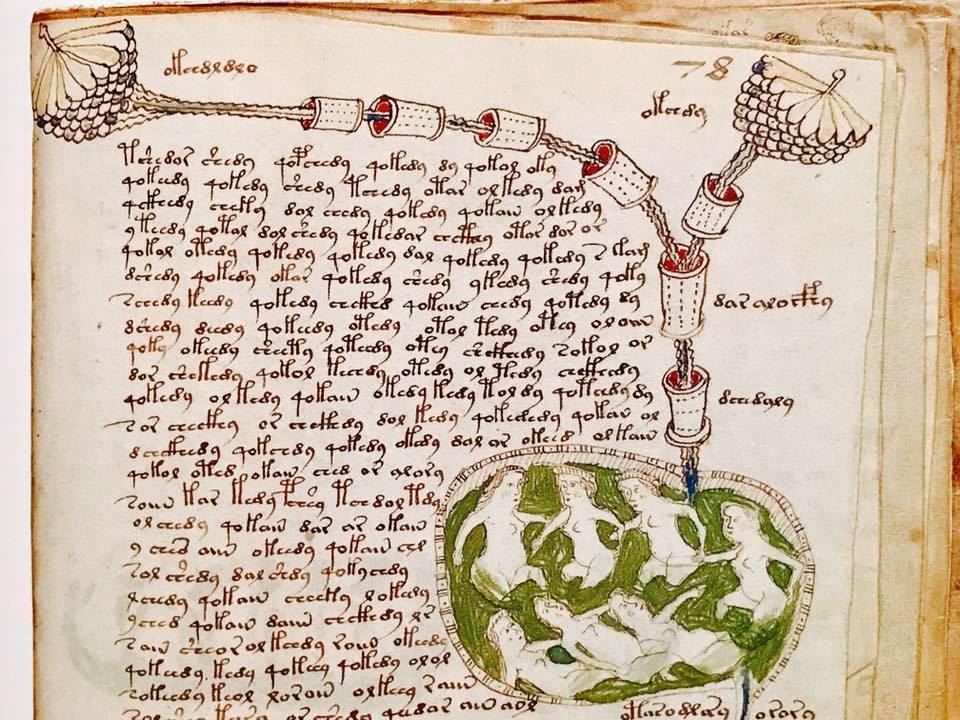The Voynich Manuscript

This week’s mystery features what is perhaps the strangest, most baffling book of all time–the Voynich Manuscript.
Written by an unknown author (or authors) in a language that has yet to be decoded, the manuscript is stunning in its complexity. It’s 234 pages long with each page containing writing in an unknown language joined by mysterious illustrations. Glancing through the images, the book appears to be some kind of encyclopedia or instruction manual, or a codex containing medicinal, botanical, or perhaps alchemical information.
And yet, to date, no one has deciphered what any of it means.
Scientists have carbon dated the vellum pages and found the book to be written in the 1400s. The book would have required somewhere between 14 and 16 complete calfskins to create–so it wasn’t an inexpensive endeavor. Whoever the author or authors were, the information they recorded in the tome was likely valuable to them–and to their peers. Previous owners of the book included emperors, imperial pharmacologists, and famous occultists, all trying to decode the mysterious book to no avail.
What makes the book so fascinating is that, for all intents and purposes, it appears to be real (as in, not a hoax. However, I must admit that plenty of people do think it’s a hoax–just a super elaborate one.) It’s got discernible structure, the writing is fluid as though written by someone with some fluency in the script, and it’s carefully organized. Nothing about the book is haphazard or slipshod.
The tome is divided into four sections. The first is the herbal or botanical section, where the authors have illustrated the anatomy of various plants. The problem is, none of these plants appear anywhere in nature. The second section is astrological, but the drawings don’t match the astronomy of any known calendar. The third section is the naked women section filled with bizarre images of nude women lounging in green water. Some call this the “biological” section, but I like my terminology better. And then finally we get the pharmacological section, which is similar to the botanical section but seems to depict formulations for several herbs together–recipes, perhaps. But for what? Tea? Pain relief medication? Hallucinogens? We just don’t know.
The book is written in a language we now call “Voynichese,” and again, no one knows what to make of it. Throughout history, the world’s greatest codebreakers have tried to decipher it, including scholars who studied Egyptian hieroglyphics and modern-day cryptologists who went on to form the NSA. But if it is written in code, no one has yet to find the cipher.
Other scholars suggest it’s not a code at all, but perhaps a form of synthesized language. Based on the recurrence and order of certain letters in the manuscript, some linguists suggest that there is a rhythm in the writings found in a natural language. In other words, it’s not just pretty gibberish. The writing is based on something–but absolutely no one knows what.
Over time, a slew of folks have claimed to decode the manuscript, but every claim has been debunked. Today, the book resides at the Beinecke Rare Book and Manuscript Library at Yale University. You can view it online.
Where did this book come from? Who wrote it? And most importantly–what the heck does it say?
There is no shortage of theories as to the book’s origins. Here are some of my favorite theories.
My favorite supernatural theory: It was written by or at least delivered by aliens imparting knowledge about their world.
My favorite psychological theory: Glossolalia is responsible for the strange text–speaking in tongues. A language is delivered to the author via trance or hysteria for him and him alone. A corollary to this theory suggests the author may have suffered mental illness, but given that modern research suggests the book actually has between 2 and 8 authors (based on the handwriting), maybe this isn’t so likely.
My favorite academic theory: The manuscript was an early attempt either to create a universal language OR to backward engineer the world’s original language from which all other languages supposedly are derived. As a word nerd, I love this idea. But this doesn’t explain all the nutty drawings. (However, some scholars note that the plant drawings are often hybrids containing the roots of one plant, the leaves of a second, and the flowers of a third. Which might support an “original world” theory.)
